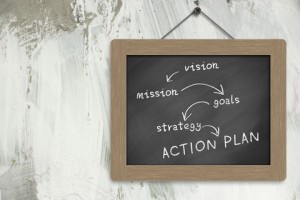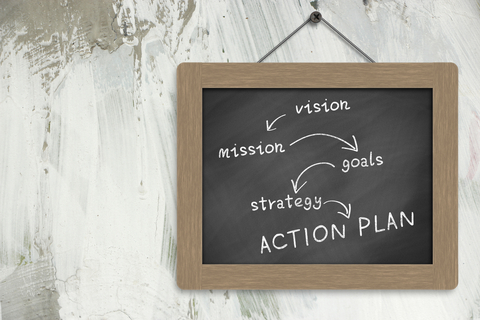Creating a Vision
A vision describes WHAT people in the organization collectively aspire to create and deliver to the world. Vision inspires people to achieve something that matters, to reach beyond their grasp. On a more practical level it helps determine what people focus on and what they don’t. Vision sets the foundation for goals, strategies and actions.
To assure commitment and accountability, involve the right people in molding the vision. Here’s a basic recipe. It works best if you adjust and flavor, as needed, for your organization.

1. Articulate your individual and organizational purpose
Creating a vision begins with HOW and WHY you want to affect the world around you. You can find two methods for uncovering your purpose and a few examples here.
2. Bring the Right People together and create the Right Environment
Include your team, the ones who must be inspired by the vision.
Steer clear of your usual meeting rooms and create a more playful space where people can move around. Visioning is a creative process and an aspirational mindset. Moving while thinking helps us think better, especially when creativity is called for. (Give Your Ideas Some Legs). Access to the outdoors is ideal, but an indoor space in which people can walk around, will do. Toys and colors help. Consider peppering the room with clay, colored pencils and markers, Legos. Cover tables and walls with paper. Encourage people to doodle and draw visual images of what’s in their minds. You’ve heard the stories of great business ideas that were drawn on napkins. Bring napkins.
3. Identify the ground-rules and desired outcomes
Here are a few for your consideration:
- We are here to create our future by answering the questions “Who will we be as an organization and what will we create together?”
- This is a time to ask what, not how. We will ask how later.
- We will talk about our greatest aspirations, not our limits.
- We will listen to each other without judgment.
- We will listen at a deeper level. We seek first to understand before expressing our responses or point of view.
- We build on each others’ ideas, the way members of a jazz band listen to the spontaneous play of each others’ music and build upon it. Listen well.
4. Each person talks about their purpose, their why, what they care about most.
Pose questions, such as:
- Why did you choose this profession and industry?
- What do you aspire to create or achieve?
- When you look back on your career, what achievements do you want to see? What’s the legacy you hope to leave?
As people speak, themes emerge. These themes become the group’s collective purpose and lead to a vision.
5. Paint the future.
People typically work in smaller groups (of up to 5), to grow the collective purpose into a picture of the future they seek to create. Encourage people to paint with words and images so others can “see” the picture. Each group presents their vision to the larger group. Common themes emerge.
6. Review.
A special team takes themes from the day and draws a picture of the future for review by the larger team.
Now you have a collective vision.
Vision Statement Examples
To develop a perfect search engine.
Dell
Provide high quality superb value technology, superior customer service and support; easy to buy, easy to use.
(Note that Dell is not creating new technology. Vision determines what you do and what you don’t do.)
To develop a perfect search engine.
Dana-Farber
Dana-Farber Cancer Institute’s ultimate goal is the eradication of cancer, AIDS, and related diseases and the fear that they engender.
Our mission is to provide expert, compassionate care to children and adults with cancer while advancing the understanding, diagnosis, treatment, cure, and prevention of cancer and related diseases.


